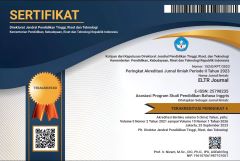THE IMPACT OF SELF-MONITORING ON STUDENTS’ CLASSROOM PARTICIPATION: THE CASE STUDY OF STUDENTS OF ENGLISH IN MOHAMED FIRST UNIVERSITY, OUJDA
Abstrak terlihat: 666 / PDF terunduh: 414DOI:
https://doi.org/10.37147/eltr.v4i2.72Keywords:
self-monitoring, classroom participation, high self-monitors, expressive behaviorAbstract
Self-monitoring is an intriguing psychological construct that has been receiving much attention from the part of the researchers in a wide range of disciplines. At its core rests the proposition that individuals have the ability to control their expressive behavior, and that they vary in the extent of doing so. This difference results in different outcomes regarding how people behave in their social interactions. Since its inception in the 1970s, myriad articles were written on self-monitoring, and many studies were conducted to explore its effects on people’s performance in a variety of contexts; this comprises schools, universities and hospitals, for example. The paper aimed to explore the influence of self-monitoring on students’ classroom participation, since no study has ever been conducted in this regard. To attain this aim, 121 of students of English in Mohamed First University in Oujda were selected to participate in this study. The results have shown that self-monitoring indeed affects students’ classroom participation. The difference between students who are high self-monitors and those who are low self-monitors, which is manifested in how they think and behave and on which basis they do so, accounts for their differing performance related to the various aspects of classroom participation.
Downloads
References
Berscheid, E., Graziano, W., Monson, T., & Dermer, M. (1976). Outcome dependency: Attention, attribution, and attraction. Journal of Personality and Social Psychology. doi: 10.1037//0022-3514.34.5.978
Boudreaux, M. J., & Ozer, D. J. (2015). Five Factor Model of Personality, Assessment of. International Encyclopedia of the Social & Behavioral Sciences, 230–235. doi: 10.1016/b978-0-08-097086-8.25061-7
Braisby, N., & Gellatly, A. (2012). Cognitive psychology. Oxford: Oxford University Press.
Briggs, S. R., Cheek, J. M., & Buss, A. H. (1980). An analysis of the Self-Monitoring Scale. Journal of Personality and Social Psychology, 679–686. doi: 10.1037/0022-3514.38.4.679
Briggs, S. R., & Cheek, J. M. (1988). On the nature of self-monitoring: Problems with assessment, problems with validity. Journal of Personality and Social Psychology, 663–678. doi: 10.1037//0022-3514.54.4.663
Cantor, N., & Mischel, W. (1977). Traits as prototypes: Effects on recognition memory. Journal of Personality and Social Psychology, 38–48. doi: 10.1037//0022-3514.35.1.38
Cramer, K. M., & Gruman, J. A. (2002). The Lennox and Wolfe Revised Self-Monitoring Scale: latent structure and gender invariance. Personality and Individual Differences, 627–637. doi: 10.1016/s0191-8869(01)00065-4
Gangestad, S. W., & Snyder, M. (2000). Self-monitoring: Appraisal and reappraisal. Psychological Bulletin. doi: 10.1037//0033-2909.126.4.530
Hartsuiker, R. J., & Westenberg, C. (2000). Word order priming in written and spoken sentence production. Cognition. doi: 10.1016/s0010-0277(99)00080-3
Harvey, J. H., Ickes, W. J., & Kidd, R. F. (1976). New directions in attribution research. Hillsdale, NJ: L. Erlbaum Associates.
Holzman, P. S. (n.d.). Personality. Retrieved from https://www.britannica.com/topic/personality
Ickes, W., Layden, M. A., & Barnes, R. D. (1978). Objective self-awareness and individuation: An empirical link1. Journal of Personality, 146–161. doi: 10.1111/j.1467-6494.1978.tb00607.x
John, O. P., Cheek, J. M., & Klohnen, E. C. (1996). On the nature of self-monitoring: Construct explication with Q-sort ratings. Journal of Personality and Social Psychology, 763–776. doi: 10.1037/0022-3514.71.4.763
Jones, E. E., & Baumeister, R. F. (1976). The self-monitor looks at the ingratiator1. Journal of Personality, 654–674. doi: 10.1111/j.1467-6494.1976.tb00144.x
Kudret, S., Erdogan, B., & Bauer, T. N. (2019). Self-monitoring personality trait at work: An integrative narrative review and future research directions. Journal of Organizational Behavior, 193–208. doi: 10.1002/job.2346
Lennox, R. D., & Wolfe, R. N. (1984). Revision of the Self-Monitoring Scale. Journal of Personality and Social Psychology, 1349–1364. doi: 10.1037//0022-3514.46.6.1349
Lippa, R. (1978). Expressive control, expressive consistency, and the correspondence between expressive behavior and personality1. Journal of Personality, 438–461. doi: 10.1111/j.1467-6494.1978.tb01011.x
Magnusson, D., & Endler, N. S. (1977). Personality at the crossroads: current issues in interactional psychology. Hillsdale, NJ: Lawrence Erlbaum Associates.
Markus, H. (1977). Self-schemata and processing information about the self. Journal of Personality and Social Psychology, 63–78. doi: 10.1037//0022-3514.35.2.63
Motley, M. T., Camden, C. T., & Baars, B. J. (1982). Covert formulation and editing of anomalies in speech production: Evidence from experimentally elicited slips of the tongue. Journal of Verbal Learning and Verbal Behavior, 21(5), 578–594. doi: 10.1016/s0022-5371(82)90791-5
Oelze, P. (2018, February 13). How Useful Is Self-Monitoring? Retrieved from https://www.betterhelp.com/advice/general/how-useful-is-self-monitoring/
Price, R., & Bouffard, D. (1981). Behavioral Appropriateness and Situational Constraint as Dimensions of Social Behavior. The Psychology of Social Situations, 26–39. doi: 10.1016/b978-0-08-023719-0.50011-5
Sampson, E. E. (1978). Personality and the location of identity1. Journal of Personality, 552–568. doi: 10.1111/j.1467-6494.1978.tb01017.x
Schachter, S., & Singer, J. (1963). "Cognitive, social, and physiological determinants of emotional state": Erratum. Psychological Review, 121–122. doi: 10.1037/h0038845
(2019). Self-Monitoring. Retrieved from https://www.encyclopedia.com/social-sciences/applied-and-social-sciences-magazines/self-monitoring
Snyder, M. (1972). Individual differences and the self-control of expressive behavior(dissertation).
Snyder, M. (1974). Self-monitoring of expressive behavior. Journal of Personality and Social Psychology. doi: 10.1037/h0037039
Snyder, M. (1974). The self-monitoring of expressive behavior. Journal of Personality and Social Psychology, 526–537.
Snyder, M. (1977). Impression management. Monterey, CA: Brooks/Cole.
Snyder, M., & Gangestad, S. (1986). On the nature of self-monitoring: Matters of assessment, matters of validity. Journal of Personality and Social Psychology. doi: 10.1037//0022-3514.51.1.125
Tesser, A. (1978). Self-Generated Attitude Change. Advances in Experimental Social Psychology, 289–338. doi: 10.1016/s0065-2601(08)60010-6
Downloads
Published
How to Cite
Issue
Section
License
Copyright (c) 2020 Abdellah El Boubekri, Moad Benyahia

This work is licensed under a Creative Commons Attribution-ShareAlike 4.0 International License.













